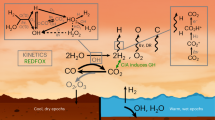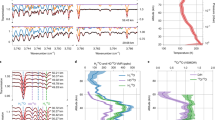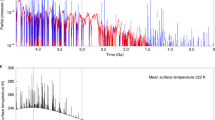Abstract
It is still unknown how much water has escaped from Mars during its history. Hydrogen escape from Mars’s atmosphere probably played a major role in drying the planet, but present-day H loss rates (~3 × 1026 atoms per second on average) cannot explain the geological evidence for the large volumes of liquid water on ancient Mars. Here we used the three-dimensional Mars-Planetary Climate Model to show that H loss rates could have increased by more than one order of magnitude (6 × 1027 atoms per second) during higher spin axis obliquity periods, notably in the last few million years when Mars’s obliquity was about 35° on average. The resulting accumulated H escape over Mars’s history translates into an ~80 m global equivalent layer, which is close to the lower limit of geological estimates, assessing the major role of atmospheric escape in drying Mars.
This is a preview of subscription content, access via your institution
Access options
Access Nature and 54 other Nature Portfolio journals
Get Nature+, our best-value online-access subscription
27,99 € / 30 days
cancel any time
Subscribe to this journal
Receive 12 digital issues and online access to articles
118,99 € per year
only 9,92 € per issue
Buy this article
- Purchase on SpringerLink
- Instant access to full article PDF
Prices may be subject to local taxes which are calculated during checkout




Similar content being viewed by others
Data availability
The outputs from Mars-PCM used in this paper are available in NetCDF format via Zenodo at https://doi.org/10.5281/zenodo.15041471 (ref. 55).
Code availability
Mars-PCM is freely available from https://svn.lmd.jussieu.fr/Planeto/trunk. For the high-obliquity simulations, the starting files for obliquity 30° and obliquity 35° (in NetCDF format) are available via Zenodo at https://doi.org/10.5281/zenodo.15041471 (ref. 55).
References
Carr, M. H. Water on Mars. Nature 326, 30–35 (1987).
Bibring, J.-P. et al. Perennial water ice identified in the south polar cap of Mars. Nature 428, 627–630 (2004).
Anderson Jr, D. E. & Hord, C. W. Mariner 6 and 7 ultraviolet spectrometer experiment: analysis of hydrogen Lyman-alpha data. J. Geophys. Res. 76, 6666–6673 (1971).
McElroy, M. B. & Donahue, T. M. Stability of the Martian atmosphere. Science 177, 986–988 (1972).
Parkinson, T. D. & Hunten, D. M. Spectroscopy and aeronomy of O2 on Mars. J. Atmos. Sci 29, 1380–1390 (1972).
Jakosky, B. M. et al. Loss of the Martian atmosphere to space: present-day loss rates determined from MAVEN observations and integrated loss through time. Icarus 315, 146–157 (2018).
Halekas, J. S. Seasonal variability of the hydrogen exosphere of Mars. J. Geophys. Res.: Planets 122, 901–911 (2017).
Mayyasi, M. et al. Solar cycle and seasonal variability of H in the upper atmosphere of Mars. Icarus 393, 115293 (2023).
Anderson Jr, D. E. Mariner 6, 7, and 9 ultraviolet spectrometer experiment: analysis of hydrogen Lyman alpha data. J. Geophys. Res. 79, 1513–1518 (1974).
Chaffin, M. S. et al. Unexpected variability of Martian hydrogen escape. Geophys. Res. Lett. 41, 314–320 (2014).
Clarke, J. T. et al. A rapid decrease of the hydrogen corona of Mars. Geophys. Res. Lett. 41, 8013–8020 (2014).
Feldman, P. D. et al. Rosetta-Alice observations of exospheric hydrogen and oxygen on Mars. Icarus 214, 394–399 (2011).
Chaffin, M. S., Deighan, J., Schneider, N. M. & Stewart, A. I. F. Elevated atmospheric escape of atomic hydrogen from Mars induced by high-altitude water. Nat. Astron. 10, 174–178 (2017).
Stone, S. W. et al. Hydrogen escape from Mars is driven by seasonal and dust storm transport of water. Science 370, 824–831 (2020).
Heavens, N. G. et al. Hydrogen escape from Mars enhanced by deep convection in dust storms. Nat. Astron. 2, 126–132 (2018).
Chaffin, M. S. et al. Martian water loss to space enhanced by regional dust storms. Nat. Astron. 5, 1036–1042 (2021).
Montmessin, F. et al. Reappraising the production and transfer of hydrogen atoms from the middle to the upper atmosphere of Mars at times of elevated water vapor. J. Geophys. Res.: Planets 127, e07217 (2022).
Kleinböhl, A. et al. Hydrogen escape on Mars dominated by water vapour photolysis above the hygropause. Nat. Astron. 8, 827–837 (2024).
Chaufray, J. Y. et al. Study of the hydrogen escape rate at Mars during Martian years 28 and 29 from comparisons between SPICAM/Mars Express observations and GCM-LMD simulations. Icarus 353, 113498 (2021).
Carr, M. H. & Head, J. W. Oceans on Mars: an assessment of the observational evidence and possible fate. J. Geophys. Res.: Planets 108, 5042 (2003).
Scheller, E. L., Ehlmann, B. L., Hu, R., Adams, D. J. & Yung, Y. L. Long-term drying of Mars by sequestration of ocean-scale volumes of water in the crust. Science 372, 56–62 (2021).
Forget, F., Byrne, S., Head, J. W., Mischna, M. A. & Schörghofer, N. in The Atmosphere and Climate of Mars (eds Haberle, R. M. et al.) 497–525 (Cambridge Univ. Press, 2017).
Laskar, J. et al. Long term evolution and chaotic diffusion of the insolation quantities of Mars. Icarus 170, 343–364 (2004).
Madeleine, J.-B. et al. Recent ice ages on Mars: the role of radiatively active clouds and cloud microphysics. Geophys. Res. Lett. 41, 4873–4879 (2014).
Jakosky, B. M. Atmospheric Loss to Space and the History of Water on Mars. Annu. Rev. Earth Planet. Sci. https://doi.org/10.1146/annurev-earth-062420-052845 (2021).
Alsaeed, N. R. & Jakosky, B. M. Mars water and D/H evolution From 3.3 Ga to present. J. Geophys. Res.: Planets 124, 3344–3353 (2019).
Cangi, E. M., Chaffin, M. S. & Deighan, J. Higher Martian atmospheric temperatures at all altitudes increase the D/H fractionation factor and water loss. J. Geophys. Res.: Planets 125, e2020JE006626 (2020).
Chaufray, J. Y. et al. Simulations of the hydrogen and deuterium thermal and non-thermal escape at Mars at spring equinox. Icarus 418, 116152 (2024).
Vals, M. et al. Improved modeling of Mars’ HDO cycle using a Mars’ global climate model. J. Geophys. Res.: Planets 127, e07192 (2022).
Rossi, L. et al. The HDO cycle on Mars: comparison of ACS observations with GCM simulations. J. Geophys. Res.: Planets 127, e07201 (2022).
Navarro, T. et al. Global climate modeling of the Martian water cycle with improved microphysics and radiatively active water ice clouds. J. Geophys. Res.: Planets 119, 1479–1495 (2014).
Krasnopolsky, V. A. Photochemistry of water in the Martian thermosphere and its effect on hydrogen escape. Icarus 321, 62–70 (2019).
Chaufray, J.-Y. et al. Variability of the hydrogen in the Martian upper atmosphere as simulated by a 3D atmosphere–exosphere coupling. Icarus 245, 282–294 (2015).
Montabone, L. et al. Martian year 34 column dust climatology from Mars Climate Sounder Observations: reconstructed maps and model simulations. J. Geophys. Res.: Planets 125, e06111 (2020).
Richardson, M. I. & Wilson, R. J. A topographically forced asymmetry in the Martian circulation and climate. Nature 416, 298–301 (2002).
Montmessin, F. The orbital forcing of climate changes on Mars. Space Sci. Rev. 125, 457–472 (2006).
Richardson, M. I. & Wilson, R. J. Investigation of the nature and stability of the Martian seasonal water cycle with a general circulation model. J. Geophys. Res.: Planets https://doi.org/10.1029/2001JE001536 (2002).
Haberle, R. M. et al. Radiative effects of water ice clouds on the Martian seasonal water cycle. In Proc. Mars Atmosphere: Modelling and Observation (eds Forget, F. & Millour, E.) 223–226 (2011); http://www-mars.lmd.jussieu.fr/paris2011/program.html
Lasue, J. et al. Quantitative assessments of the Martian hydrosphere. Space Sci. Rev. 174, 155–212 (2013).
Levrard, B., Forget, F., Montmessin, F. & Laskar, J. Recent ice-rich deposits formed at high latitudes on Mars by sublimation of unstable equatorial ice during low obliquity. Nature 431, 1072–1075 (2004).
Forget, F., Haberle, R., Montmessin, F., Levrard, B. & Head, J. Formation of glaciers on Mars by atmospheric precipitation at high obliquity. Science 311, 368–371 (2006).
Madeleine, J.-B. et al. Amazonian northern mid-latitude glaciation on Mars: a proposed climate scenario. Icarus 203, 390–405 (2009).
Kurokawa, H. et al. Evolution of water reservoirs on Mars: constraints from hydrogen isotopes in Martian meteorites. Earth Planet. Sci. Lett. 394, 179–185 (2014).
González-Galindo, F. et al. Variability of the Martian thermosphere during eight Martian years as simulated by a ground-to-exosphere global circulation model. J. Geophys. Res.: Planets 120, 2020–2035 (2015).
Montabone, L. et al. Eight-year climatology of dust optical depth on Mars. Icarus 251, 65–95 (2015).
Liu, S. C. & Donahue, T. M. The regulation of hydrogen and oxygen escape from Mars. Icarus 28, 231–246 (1976).
González-Galindo, F., Forget, F., López-Valverde, M. A., Angelats i Coll, M. & Millour, E. A ground-to-exosphere Martian general circulation model. 1. Seasonal, diurnal, and solar cycle variation of thermospheric temperatures. J. Geophys. Res.: Planets https://doi.org/10.1029/2008JE003246 (2009).
Lefèvre, F. et al. Relationship between the ozone and water vapor columns on Mars as observed by SPICAM and calculated by a global climate model. J. Geophys. Res.: Planets 126, e06838 (2021).
González-Galindo, F. et al. 3D Martian ionosphere model. I. The photochemical ionosphere below 180 km. J. Geophys. Res.: Planets 118, 2105–2123 (2013).
Naar, J. Modélisation du cycle de l’eau actuel et des derniers âges glaciaires de la planete Mars. PhD thesis, Polytechnic Institute of Paris (2023); https://doi.org/10.13140/RG.2.2.31506.84162
Neary, L. et al. Explanation for the increase in high-altitude water on Mars observed by NOMAD during the 2018 global dust storm. Geophys. Res. Lett. https://doi.org/10.1029/2019GL084354 (2020).
Shaposhnikov, D. S., Medvedev, A. S., Rodin, A. V. & Hartogh, P. Seasonal water ‘pump’ in the atmosphere of Mars: vertical transport to the thermosphere. Geophys. Res. Lett. 46, 4161–4169 (2019).
Withers, P. A review of observed variability in the dayside ionosphere of Mars. Adv. Space Res. 44, 277–307 (2009).
Holmes, J. A. et al. Enhanced water loss from the Martian atmosphere during a regional-scale dust storm and implications for long-term water loss. Earth Planet. Sci. Lett. 571, 117109 (2021).
Gilli, G. & González-Galindo, F. Mars Planetary Climate Model (MPCM) simulations during higher spin-axis obliquity periods. Zenodo https://doi.org/10.5281/zenodo.15041471 (2025).
Chaffin, M. S. et al. Mars H escape rates derived from MAVEN/IUVS Lyman alpha brightness measurements and their dependence on model assumptions. J. Geophys. Res.: Planets 123, 2192–2210 (2018).
Clarke, J. T. Dust-enhanced water escape. Nat. Astron. 2, 114–115 (2018).
Wolkenberg, P., Giuranna, M., Smith, M. D., Grassi, D. & Amoroso, M. Similarities and differences of global dust storms in MY 25, 28, and 34. J. Geophys. Res.: Planets 125, e2019JE006104 (2020).
Acknowledgements
The IAA team (F.G.-G., G.G., M.Á.L.-V. and A.B.) were funded by the Spanish Ministerio de Ciencia, Innovación y Universidades, the Agencia Estatal de Investigación and EC FEDER funds (Projects RTI2018-100920-J-I00, PGC2018-101836-B-100 and PID2022-137579NB-I00), and they acknowledge financial support from a Severo Ochoa grant (No. CEX2021-001131-S), funded by MCIN/AEI/10.13039/501100011033. G.G. acknowledges financial support from the Junta de Andalucía through the programme EMERGIA 2021 (EMC21 00249). J.-Y.C. was partially funded by the Programme National de Planetologie of CNRS-INSU co-funded by CNES and the Programme National Soleil Terre of CNRS-INSU co-funded by CNES and CEA. This project has received funding from the European Research Council under the European Union’s Horizon 2020 research and innovation programme (Grant Agreement No. 835275).
Author information
Authors and Affiliations
Contributions
G.G. performed the simulations for high obliquity, analysed the results, discussed their implications and wrote the first version of the paper. F.G.-G. conceived the study, contributed to the development and extension of the photochemical model and performed the simulations for the current obliquity. J.-Y.C. contributed to the extension of the photochemical model and implemented the calculation of escape rates in Mars-PCM. E.M. and F.F. are the main developers of Mars-PCM and provided support for running the simulations. F.M., J.N., M.V. and L.R. contributed to improving the water cycle in the model. M.Á.L.-V. and A.B. contributed to validating the water cycle in the model. F.L. and Y.L. contributed to the development of the photochemical model and performed the spin-up for the high-obliquity simulations. All authors participated in discussions on the results and contributed to the preparation of the paper.
Corresponding author
Ethics declarations
Competing interests
The authors declare no competing interests.
Peer review
Peer review information
Nature Astronomy thanks the anonymous reviewers for their contribution to the peer review of this work.
Additional information
Publisher’s note Springer Nature remains neutral with regard to jurisdictional claims in published maps and institutional affiliations.
Extended data
Extended Data Fig. 1 Effect of the different processes over the simulated H escape.
Panel a: H escape simulated by the Mars-PCM for solar average conditions and the climatological dust scenario, for a reference simulation using the same physics as in19 (black line), a simulation including the H2O microphysical model but not the H2O-ion photochemistry (blue line line), and a simulation including the both the H2O microphysical model and the extended H2O ionospheric reactions (blue line). Panel b: Ratio of the simulated H escape rate with respect to the reference simulation.
Extended Data Fig. 2 Effect of the inclusion of H2O microphysical scheme at high obliquity.
Simulations with (red) and without (purple) microphysics after 1 Mars year: the H-loss rate is up to two orders of magnitude larger when the H2O microphysics is included, and the annually integrated H-loss is a factor 28.6 larger. This suggests that radiative active clouds also played a key role in changing the water content and H loss in the Mars past conditions.
Extended Data Fig. 3 Effects of global dust storms on the current escape rate.
Globally integrated H escape rate for MY25 (panel a), MY28 (panel b) and MY34 (panel c) simulated by the Mars-PCM forced with the UV solar flux for each year, and the observed dust load for each year (black lines) or the climatological dust scenario (red lines). The vertical dotted lines mark the approximate starting point of each storm (Ls=185 for MY25 and MY34, Ls=265 for MY2858. Including the dust storms further increases the H escape rate in between 16% and 33%.
Supplementary information
Supplementary Information
Supplementary Table 1.
Rights and permissions
Springer Nature or its licensor (e.g. a society or other partner) holds exclusive rights to this article under a publishing agreement with the author(s) or other rightsholder(s); author self-archiving of the accepted manuscript version of this article is solely governed by the terms of such publishing agreement and applicable law.
About this article
Cite this article
Gilli, G., González-Galindo, F., Chaufray, JY. et al. Increased hydrogen escape from Mars atmosphere during periods of high obliquity. Nat Astron (2025). https://doi.org/10.1038/s41550-025-02561-3
Received:
Accepted:
Published:
DOI: https://doi.org/10.1038/s41550-025-02561-3



